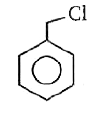Which of the following substrates is/are more reactive than ethyl bromide for SN2 reaction?
Br−CH2−Br
OHC−CH2−Br
CH2=CH−CH2−Br
Ph−CH2−Br
The correct Answer is:B, C, D
To determine which substrates are more reactive than ethyl bromide (CH3CH2Br) for an SN2 reaction, we need to analyze the structure of the given substrates and their ability to stabilize the transition state.
1. Identify Ethyl Bromide Structure:
- Ethyl bromide is represented as CH3CH2Br. It has a primary carbon (the carbon attached to the bromine is attached to only one other carbon).
2. Understand SN2 Reaction Mechanism:
- The SN2 reaction involves a nucleophile attacking the electrophilic carbon (the carbon attached to the leaving group, in this case, bromine) and simultaneously displacing the leaving group (Br). The rate of the reaction is influenced by sterics and the nature of substituents on the carbon.
3. Effect of Electron-Withdrawing Groups:
- Electron-withdrawing groups (EWGs) on the beta carbon (the carbon adjacent to the one with the leaving group) can stabilize the transition state, increasing the reactivity of the substrate in SN2 reactions. Examples of EWGs include carbonyl groups (C=O).
4. Analyze Each Given Option:
- Option A: If the substrate has an EWG on the alpha carbon, it will not enhance the reactivity as effectively as having it on the beta carbon. Thus, it is less reactive than ethyl bromide.
- Option B: If the substrate has an EWG on the beta carbon, it will significantly enhance the reactivity, making it more reactive than ethyl bromide.
- Option C: Allylic bromides (where the bromine is attached to a carbon adjacent to a double bond) are known to be highly reactive in SN2 reactions due to resonance stabilization. Thus, this substrate is more reactive than ethyl bromide.
- Option D: Similar to option C, benzylic bromides (where the bromine is attached to a carbon adjacent to a benzene ring) are also very reactive due to resonance effects. Therefore, this substrate is also more reactive than ethyl bromide.
5. Conclusion:
- Based on the analysis, options B, C, and D are more reactive than ethyl bromide for SN2 reactions.
Final Answer:
The correct options that are more reactive than ethyl bromide for SN2 reactions are B, C, and D.
- Ethyl bromide is represented as CH3CH2Br. It has a primary carbon (the carbon attached to the bromine is attached to only one other carbon).
- The SN2 reaction involves a nucleophile attacking the electrophilic carbon (the carbon attached to the leaving group, in this case, bromine) and simultaneously displacing the leaving group (Br). The rate of the reaction is influenced by sterics and the nature of substituents on the carbon.
- Electron-withdrawing groups (EWGs) on the beta carbon (the carbon adjacent to the one with the leaving group) can stabilize the transition state, increasing the reactivity of the substrate in SN2 reactions. Examples of EWGs include carbonyl groups (C=O).
- Option A: If the substrate has an EWG on the alpha carbon, it will not enhance the reactivity as effectively as having it on the beta carbon. Thus, it is less reactive than ethyl bromide.
- Option B: If the substrate has an EWG on the beta carbon, it will significantly enhance the reactivity, making it more reactive than ethyl bromide.
- Option C: Allylic bromides (where the bromine is attached to a carbon adjacent to a double bond) are known to be highly reactive in SN2 reactions due to resonance stabilization. Thus, this substrate is more reactive than ethyl bromide.
- Option D: Similar to option C, benzylic bromides (where the bromine is attached to a carbon adjacent to a benzene ring) are also very reactive due to resonance effects. Therefore, this substrate is also more reactive than ethyl bromide.
- Based on the analysis, options B, C, and D are more reactive than ethyl bromide for SN2 reactions.
The correct options that are more reactive than ethyl bromide for SN2 reactions are B, C, and D.
Topper's Solved these Questions
Similar Questions
Knowledge Check
Which of the following is most reactive towardSN2 reaction ?
A B
B C
C D
D
Which of the following is most reactive towardSN2 reaction ?
ACH2=CH−CH2−ClBPh−CH2−ClC DPh−C∣∣O−CH2−Cl
DPh−C∣∣O−CH2−ClWhich of the following are SN2 reactions?
A B
B C
C D
D
Which of the following is least reactive towards SN1?
View SolutionMost reactive halide towards SN1 reactions is
View SolutionWhy is ICI more reactive than I2?
View SolutionLithium is more reactive than potassium.
View SolutionIn the given pairs of alkyl-halide, in which pair the first compound is more reactive than second compound toward SN2 reaction ?
View Solution